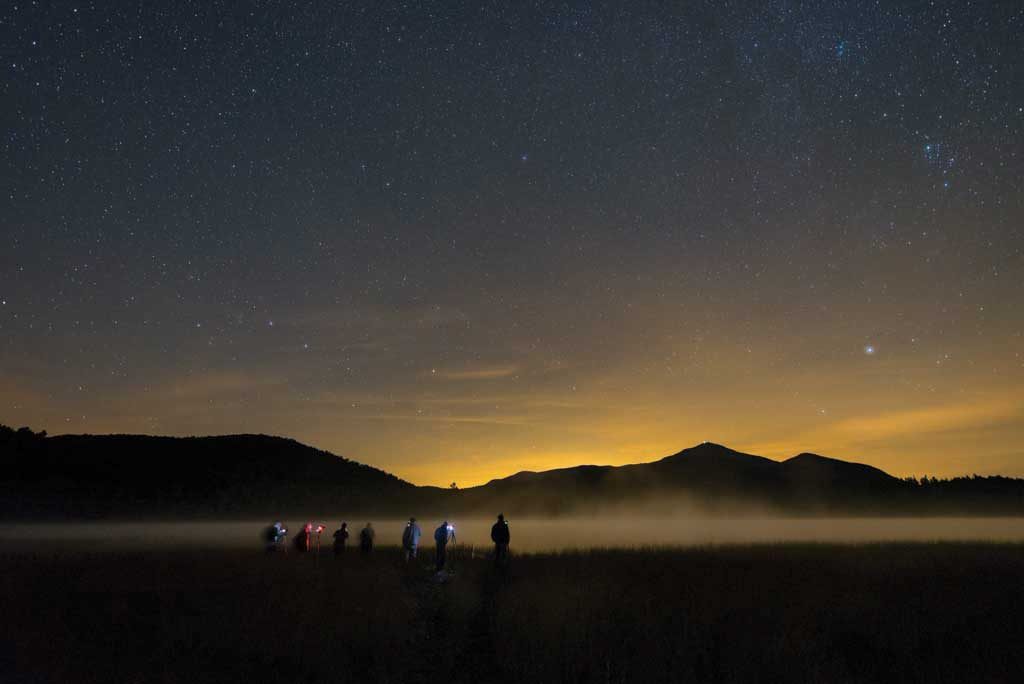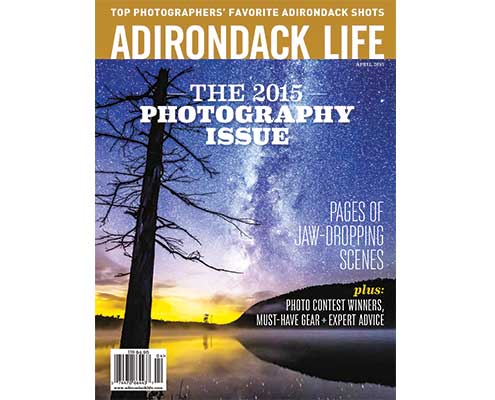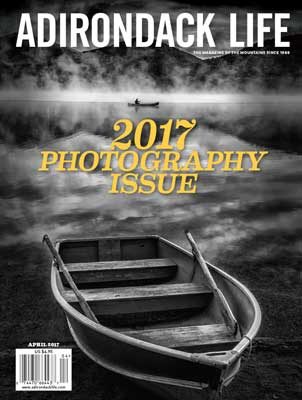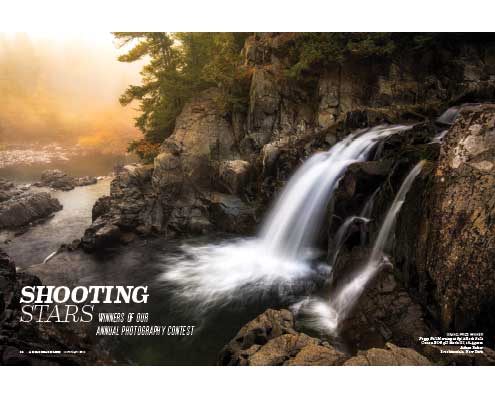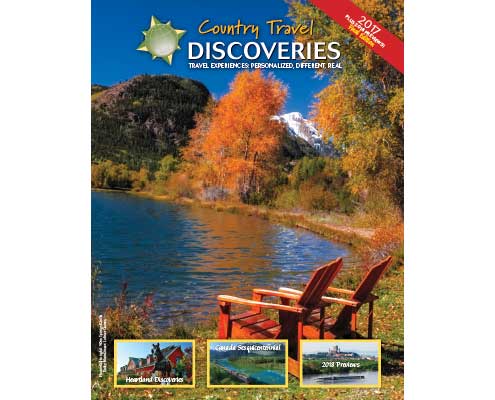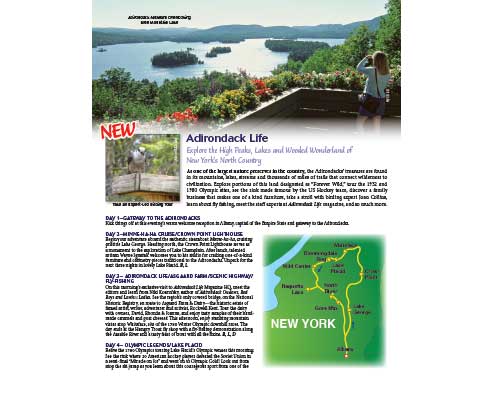Engage Beyond the Page
Connecting with readers through workshops, contests, and tours
By Elizabeth Folwell
Photography — exceptional photography — is at Adirondack Life’s core, the beating heart of this regional magazine since 1969. It’s what longtime subscribers and casual readers alike tell us they love most — not the profiles of unusual characters, the descriptions of great hikes, the harrowing tales of backcountry misadventures. They want the visual cues that make a cherished place accessible even when they’re a thousand miles away.
So, picture this: It’s 1:40 a.m. in a log lodge deep in the Adirondacks. Dozens of people are snug in their bunks beneath Hudson Bay blankets. A handful of others are drinking beer and listening intently as a renowned photographer regales them with tales of shooting in exotic places and scaling frozen peaks before dawn. “It’s all about being there,” he says. “f/8 and be there,” echoes an acolyte, quoting “Weegee,” the famous street photographer of the 1930s.
Foggy and beyond exhaustion, gathering empty longnecks, I catch the eye of Galen Crane, then our assistant editor, who feels he has to be the one to turn out the lights and tuck in the merrymakers. “Coffee and pastries will be on the table in four hours,” I say, “and the folks signed up for shooting at sunrise need to be on the porch at 6 o’clock.” No mass movement ensues, just a few more bottle caps pop off.
So went three years of Adirondack Life fall photography workshops, in which great regional photographers taught, critiqued, mingled, and made themselves accessible to rank beginners and talented amateurs alike. For the art director, assistant editor, and me, these were the culmination of weeks of work — deciding menus, assigning rooms, lining up teachers, arranging for overnight film processing, scouting locations, and working with our sponsor, Kodak.
The events were simultaneously wonderful and awful. The awful part was the hours and hours of prep, but the wonderful side, where our goal was to immerse readers in something truly special, is summed up by attendee John Radigan. “The best part about the whole thing was pulling up to Minnowbrook [Conference Center] and going to sign in. This was my first Adirondack Life workshop. Galen is sitting there and asks my name. When I tell him he says, ‘Ah … a contest winner. I voted for you to win the grand prize. I really thought you should have won.’ I was blown away, mostly because I couldn’t believe I was talking to someone who wrote for the magazine! That was the day I learned that the Adirondack Life staff were real people, too.”
More than 20 years ago, to make the relationship with our readers more participatory, we launched our first photography contest. Many, many magazines do contests. They’re an inexpensive way to fill pages while also smoking out real talent we may never otherwise find. The first contest, in 1996, brought Mark Bowie’s work to our attention — he won the grand prize for a shot of a wild iris on a lakeshore with a full moon overhead. Now he’s a regular contributor for outdoor scenes.
But the early contests, like the workshops, were absurdly labor intensive. People could send in 10 transparencies or prints along with a return envelope, and logging each murky sunset, blurry loon, tame chipmunk, adorable toddler, and misty rainbow took hours and hours. Thousands of images arrived, and thousands were returned — with only one error in two decades. The judging took many more hours as photographs were sorted, resorted, set aside, and then gathered as those worthy of a final look.
What rescued the contest, raising the bar considerably, was the digital revolution in photography. In the last eight years, we’ve streamlined the submission process, limited entries to five per person, and been rewarded with high-quality images from across the country that depict every corner of the six-million-acre Adirondack Park. The judging is still painstaking, but it’s also a fine way to see the park as others do.
We’ve also tried other improvements with our contest. As with many efforts to evolve, this hasn’t been a straight line to success, but a process of trial and error.
Take, as an example, our special photography issues. We have featured our contest images in the March/April issue since the program was launched 21 years ago, and it has always boosted sales appreciably. Given that success and our readers’ deep interest in Adirondack photography, we published special issues in 1997 and 1998 featuring an array of contemporary photography plus great historical articles about the men who first captured this remarkable place on glass-plate negatives. To our surprise, these issues failed to grab significant newsstand sales, so we tabled the idea.
Fast forward to 2015. In an attempt to renew this focus on photography from cover to cover, we filled March/April with handsome images, hands-on advice, and links to time-lapse films — but we also tried something different. We pulled framed photographs together in a special exhibition at View, a gorgeous new multiarts center in Old Forge, New York. The gallery director helped assemble and publicize the show. We projected the time-lapse image that was our issue cover on a wall of the main gallery and displayed our contest winners’ scenes on a big monitor in the lobby. In another part of the gallery, we ran an amazing video by Nathan Farb, arguably the best-known regional photographer since the 1970s, showing large-format images he had created over three decades.
Presenting this kind of interactive experience, where visitors could do more than just turn pages, garnered much attention from regional radio and television, publicity that is hard to accomplish in an area that has few media outlets and nearly a quarter of New York state to cover. It also attracted readers from central and western New York — as far away as Syracuse — who made the trip to see the show.
That success was well earned, and we subsequently decided to devote every other March/April issue to Adirondack photography with a beyond-print twist. In 2017, rather than images hanging on gallery walls, we worked with the Wild Center, a state-of-the-art natural history museum and environmental center in Tupper Lake, to create a 10-minute video of scenes from that issue that plays several times a day in a huge auditorium. We expect tens of thousands of viewers this spring, summer, and fall to see this engrossing program and become familiar with the high-quality images we present in the magazine. Our hope is to show longtime readers just how astonishing these photographs are, while introducing a whole new audience to the publication.
BUILDING RELATIONSHIPS THAT LAST
All publications want to cultivate readers beyond the subscription level. We want them to wear T-shirts and hats with our logos, buy our mugs, give wall calendars to their friends. But it takes more than being passive salespeople to build relationships that last.
We see big-name publishers getting this. In May, The New York Times obit team did a lecture that readers could attend; The New Yorker has a weekly hourlong program on NPR featuring staff writers and editors. National Geographic’s tours offer cultural immersion and access to exotic places. Rolling Stone’s epic Super Bowl parties extend the brand into bacchanal. Arizona Highways sponsors numerous workshops, from camera-toting tours of the state’s natural wonders to intensive computer sessions teaching the latest imaging software. Cooking Light and Health partner with John Hancock insurance to present the Fit Foodie Festival, which includes 5- and 10-kilometer runs plus gourmet refreshment stations and receptions. Cottage Life, based in Toronto, puts on massive expos that showcase advertisers, present workshops for homeowners, and give that rare opportunity to interact directly with the people behind the publication.
At Adirondack Life, our editorial and art staff visit colleges and career fairs. Kids come to job shadow every department. For more than 20 years, we have sponsored the annual Rustic Furniture Fair as well as a juried antiques show at the Adirondack Experience (formerly Adirondack Museum) in Blue Mountain Lake. In exchange for advertising in our magazine, we get the prime position at both shows, enabling us to sell merchandise, give away magazines, and talk one-on-one with thousands of people. What we hear at these events, as well as at paddle-sports shows and log home expos, is folks telling us they’re “members” of Adirondack Life — rather than subscribers. This shows a deep attachment — one made deeper by these in-person interactions.
And our photography workshops? We approach these differently, leveraging a key partnership. John Radigan, an avid photographer and a participant in our last workshop in 2001, launched the Adirondack Photography Institute (API) in 2005 with Nancy Rotenberg, an expert macro photographer. He saw that most National Parks have popular photography events and felt those models could be replicated here. The API runs workshops in all seasons and in numerous Adirondack locations, from the lake country to the High Peaks. Adirondack Life now co-sponsors their fall workshop.
This partnership has been a great solution for us. No longer are we booking hotel rooms and scouting locations. Now Annie Stoltie, our editor, and Kelly Hofschneider, art director, can spend their time during the workshops meeting with participants to explain the magazine’s philosophy and give solid advice on what we want to see in our contest’s submissions. In a fun twist, our 2017 winner was a product of this API/Adirondack Life synergy. Since we don’t see any information associated with the submissions until after the winners are selected, we only just recently learned the backstory of the amazing black-and-white image of Clear Pond (see image at left).
Rick Tyrseck from Danbury, Connecticut, attended the 2015 API/Adirondack Life workshop, which traveled to Elk Lake and Clear Pond in the High Peaks at the crack of dawn. Tyrseck explained that the fall colors were not yet peak, so he conceived the shot in black-and-white instead. There was a rowboat on shore, which he turned right-side-up. The foreground was looking good, and then instructor Johnathan Esper, a superb young photographer who teaches in Iceland and other exotic locales, paddled into the middle distance. The clouds cooperated, and a stunning shot was born. As the grand-prize winner, Tyrseck’s photograph was featured on our March/April cover.
STAYING THE COURSE
Adirondack Life, like the other publications featured in Pages, has a clear mission to serve its readers; to be the unswerving connection to a place, profession, or activity they love; to deliver useful information; to present news from an objective perspective; to surprise, delight, and energize. We strive to be that beloved mirror that reflects how people have interacted and will continue to interact within the region. We’ve been a consistent record of tastes and trends, pastimes and products, destinations and dreams.
We produce eight issues a year: six bimonthlies and two special issues, one devoted to outdoor recreation in a very reader-service format and the other focused on the home — architecture, decor, products, gardens, food, and energy. Our circulation is about 36,000, including a waiting-room program that puts 1,500 copies into the hands of total strangers as they wait for the dentist or hairdresser. Readership is about 150,000 given pass-through data from professional surveys. We publish a wall calendar, have produced books repurposing magazine content — from recipes to nature essays — and also
act as a custom publisher for local nonprofits that lack the editorial and production expertise to turn important research into valuable resources.
In the never-ending search for new ways to find and secure readers, we’ve headed in a very different direction this year. At the International Regional Magazine Association conference in San Diego in fall 2015, we learned that our compatriots in Nebraska and other Midwestern states were working with a high-end motor coach company to curate custom tours of their regions. It’s a win-win deal, with the company getting great ideas for out-of-the-way places to share with their guests, and the magazines getting the chance for new readers who may latch on for the long haul, given they’ll meet us in person, visit our offices, picnic on the Jay village green, and walk to the town’s covered bridge.
What we’ll get out of the bus tour is a percentage of the fee guests pay plus, we hope, a whole lot of goodwill. And that’s what reader engagement boils down to: loyalty, goodwill, and the connections that extend miles beyond the printed page.
Elizabeth (aka Betsy) Folwell is creative director of Adirondack Life. She started in 1989 as assistant editor and ascended the corporate stepladder to become a member of the publishing team with circulation director Lisa Lincoln and controller Joni Manning in 2005. New York’s Adirondack Park has been her home since 1976.

